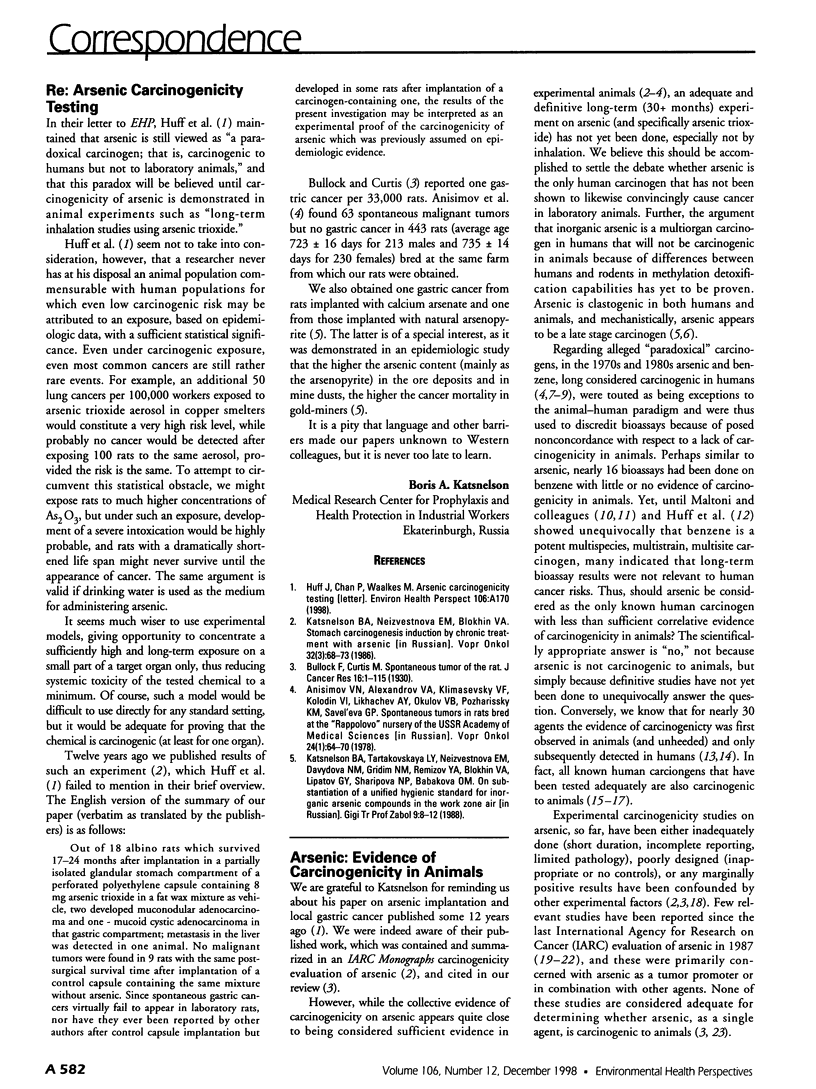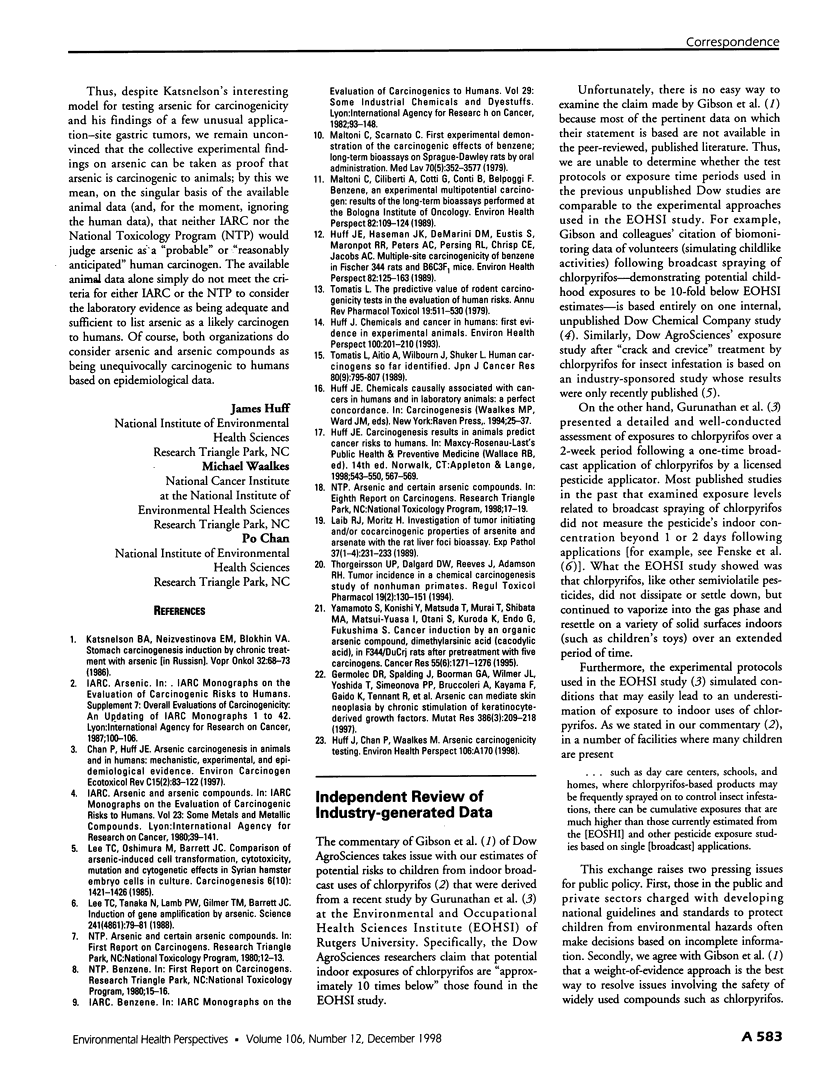Full text
PDF

Selected References
These references are in PubMed. This may not be the complete list of references from this article.
- Germolec D. R., Spalding J., Boorman G. A., Wilmer J. L., Yoshida T., Simeonova P. P., Bruccoleri A., Kayama F., Gaido K., Tennant R. Arsenic can mediate skin neoplasia by chronic stimulation of keratinocyte-derived growth factors. Mutat Res. 1997 Jun;386(3):209–218. doi: 10.1016/s1383-5742(97)00006-9. [DOI] [PubMed] [Google Scholar]
- Huff J. E., Haseman J. K., DeMarini D. M., Eustis S., Maronpot R. R., Peters A. C., Persing R. L., Chrisp C. E., Jacobs A. C. Multiple-site carcinogenicity of benzene in Fischer 344 rats and B6C3F1 mice. Environ Health Perspect. 1989 Jul;82:125–163. doi: 10.1289/ehp.8982125. [DOI] [PMC free article] [PubMed] [Google Scholar]
- Huff J., Chan P., Waalkes M. Arsenic carcinogenicity testing. Environ Health Perspect. 1998 Apr;106(4):A170–A170. doi: 10.1289/ehp.106-1532958. [DOI] [PMC free article] [PubMed] [Google Scholar]
- Huff J. Chemicals and cancer in humans: first evidence in experimental animals. Environ Health Perspect. 1993 Apr;100:201–210. doi: 10.1289/ehp.93100201. [DOI] [PMC free article] [PubMed] [Google Scholar]
- Katsnel'son B. A., Neizvestnova E. M., Blokhin V. A. Induktsiia raka zheludka pri khronicheskom deistvii mysh'iaka. Vopr Onkol. 1986;32(3):68–73. [PubMed] [Google Scholar]
- Laib R. J., Moritz H. Investigation of tumor initiating and/or cocarcinogenic properties of arsenite and arsenate with the rat liver foci bioassay. Exp Pathol. 1989;37(1-4):231–233. doi: 10.1016/s0232-1513(89)80056-8. [DOI] [PubMed] [Google Scholar]
- Lee T. C., Oshimura M., Barrett J. C. Comparison of arsenic-induced cell transformation, cytotoxicity, mutation and cytogenetic effects in Syrian hamster embryo cells in culture. Carcinogenesis. 1985 Oct;6(10):1421–1426. doi: 10.1093/carcin/6.10.1421. [DOI] [PubMed] [Google Scholar]
- Lee T. C., Tanaka N., Lamb P. W., Gilmer T. M., Barrett J. C. Induction of gene amplification by arsenic. Science. 1988 Jul 1;241(4861):79–81. doi: 10.1126/science.3388020. [DOI] [PubMed] [Google Scholar]
- Maltoni C., Ciliberti A., Cotti G., Conti B., Belpoggi F. Benzene, an experimental multipotential carcinogen: results of the long-term bioassays performed at the Bologna Institute of Oncology. Environ Health Perspect. 1989 Jul;82:109–124. doi: 10.1289/ehp.8982109. [DOI] [PMC free article] [PubMed] [Google Scholar]
- Maltoni C., Scarnato C. First experimental demonstration of the carcinogenic effects of benzene; long-term bioassays on Sprague-Dawley rats by oral administration. Med Lav. 1979 Sep-Oct;70(5):352–357. [PubMed] [Google Scholar]
- Thorgeirsson U. P., Dalgard D. W., Reeves J., Adamson R. H. Tumor incidence in a chemical carcinogenesis study of nonhuman primates. Regul Toxicol Pharmacol. 1994 Apr;19(2):130–151. doi: 10.1006/rtph.1994.1013. [DOI] [PubMed] [Google Scholar]
- Tomatis L., Aitio A., Wilbourn J., Shuker L. Human carcinogens so far identified. Jpn J Cancer Res. 1989 Sep;80(9):795–807. doi: 10.1111/j.1349-7006.1989.tb01717.x. [DOI] [PMC free article] [PubMed] [Google Scholar]
- Tomatis L. The predictive value of rodent carcinogenicity tests in the evaluation of human risks. Annu Rev Pharmacol Toxicol. 1979;19:511–530. doi: 10.1146/annurev.pa.19.040179.002455. [DOI] [PubMed] [Google Scholar]
- Yamamoto S., Konishi Y., Matsuda T., Murai T., Shibata M. A., Matsui-Yuasa I., Otani S., Kuroda K., Endo G., Fukushima S. Cancer induction by an organic arsenic compound, dimethylarsinic acid (cacodylic acid), in F344/DuCrj rats after pretreatment with five carcinogens. Cancer Res. 1995 Mar 15;55(6):1271–1276. [PubMed] [Google Scholar]


